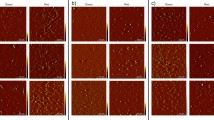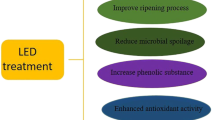Abstract
Netting has been widely used in recent years to protect apple fruit from solar injury. There is little information on the biochemical aspects underlying the effectiveness of netting against sunburn in apples. The objective of this study was to quantify the effects of netting on polyphenols, anthocyanins, and antioxidant activity in apples with different sunburn degrees in terms of fruit peel color variation. Orchards of ‘Gala Brookfield’ and ‘Fuji Raku Raku’ apples were covered in red and pearl nets (providing 20% shading), respectively. Uncovered trees served as controls for the experiments. Spectral light transmission was measured under the nets from 350 to 1700 nm. Photosynthetically active radiation (PAR), ultraviolet radiation (UV), and fruit surface temperature (FST) were evaluated from 20 to 175 day after full blooming. Red netting increased the amount of red (600–700 nm) and blue (400–500 nm) wavelengths of the visible spectrum. Both red and pearl nets reduced infrared (900–1700 nm) transmission by 8%, which resulted in a decrease around 5 °C in FST. Similarly, PAR radiation was reduced by 25 and 21% on average, while the reduction in UV radiation reached 29 and 25% with red and pearl netting, respectively. In moderate (browning; SB-3) and severe (browning with necrosis; SB-4) damage categories, sunburn decreased 15% in ‘Gala Brookfield’ under red netting, and only 4% in ‘Fuji Raku Raku’ under pearl netting. In ‘Gala Brookfield’, red netting significantly increased anthocyanin content and ferric ion-reducing antioxidant power (FRAP) antioxidant capacity for the SB4 sunburn category. In contrast, pearl netting significantly reduced the amount of polyphenols, anthocyanins, and the FRAP antioxidant capacity in SB-4 sunburn group of ‘Fuji Raku Raku’ apples. Collectively, our results suggest that sun protection provided by netting result in changes in the composition and antioxidant capacity of fruit peels, whose response varies depending on the cultivar and type of net used.








Similar content being viewed by others
References
Abdel-Hameed ES (2009) Total, phenolic contents and free radical scavenging activity of certain Egyptian Ficus species leaf samples. Food Chem 114:1271–1277. https://doi.org/10.1016/j.foodchem.2009.11.005
Ainsworth EA, Gillespie KM (2007) Estimation of total phenolic content and other oxidation substrates in plant tissues using Folin–Ciocalteu reagent. Nat Protoc 2:875–877. https://doi.org/10.1038/nprot.2007.102
Amarante CVT, Steffens CA, Argenta LC (2011) Yield and fruit quality of ‘Gala’ and ‘Fuji’ apple trees protected by white anti-hail net. Sci Hortic 129:79–85. https://doi.org/10.1016/j.scienta.2011.03.010
Andrews PK, Chalmers DJ, Moremong M (1992) Canopy-air temperature differences and soil water as predictors of water stress of apple trees grown in a humid, temperate climate. J Am Soc Hortic Sci 117:453–458. https://doi.org/10.21273/JASHS.117.3.453
Arakawa O (1988) Photoregulation of anthocyanin synthesis in apple fruit under UV-B and red light. Plant Cell Physiol 29:1385–1389. https://doi.org/10.1093/oxfordjournals.pcp.a077651
Arakawa O (1991) Effect of temperature on anthocyanin accumulation in apple fruits as affected by cultivar, stage of fruit ripening, and bagging. J Hortic Sci 66:763–768. https://doi.org/10.21273/HORTSCI.49.12.1510
Arakawa O, Hori Y, Ogata R (1985) Relative effectiveness and interaction of ultraviolet-B, red and blue light in anthocyanin synthesis of apple fruit. Plant Physiol 64:323–327. https://doi.org/10.1111/j.1399-3054.1985.tb03347.x
Arakawa O, Kikuya S, Pungpomin P, Zhang S, Tanaka N (2016) Accumulation of anthocyanin in apples in response to blue light at 450 nm: recommendations for producing quality fruit color under global warming. J Hortic Sci 81:297–302. https://doi.org/10.17660/eJHS.2016/81.6.2
Bastías RM, Corelli-Grappadelli L (2012) Light quality management in fruit orchards: physiological and technological aspects. Chil J Agric Res 72:574–581. https://doi.org/10.4067/S0718-58392012000400018
Benzie IFF, Strain JJ (1996) The ferric reducing ability of plasma (FRAP) as a measure of “antioxidant power”: the FRAP assay. Anal Biochem 239:70–76. https://doi.org/10.1006/abio.1996.0292
Blanke MM (2007) Coloured hailnets: their structure, light and UV transmission determine the colouration of apple fruit. Ewerbs Obstbau 49:127–139. https://doi.org/10.1007/s10341-007-0048-6
Blanke MM (2009) The structure of coloured-hail nets affects light transmission, light spectrum, phytochrome and apple fruit colouration. Acta Hortic 817:177–184. https://doi.org/10.17660/ActaHortic.2009.817.17
Cardeñosa V, Girones-Vilaplana A, Muriel JL, Moreno DA, Moreno-Rojas JM (2016) Influence of genotype, cultivation system and irrigation regime on antioxidant capacity and selected phenolics of blueberries (Vaccinium corymbosum L.). Food Chem 202:276–283. https://doi.org/10.1016/j.foodchem.2016.01.118
Chen LS, Li P, Cheng L (2008) Effects of high temperature coupled with high light on the balance between photooxidation and photoprotection in the sun-exposed peel of apple. Planta 228:745–756. https://doi.org/10.1007/s00425-008-0776-3
Chilean Fruit Exporters Association (2014) Apples. Expordata yearbook. Decofrut S.A., Chile, pp 626–628
Di Matteo A, Russo R, Graziani G, Ritieni A, Di Vaio C (2017) Characterization of autochthonous sweet cherry cultivars (Prunus avium L.) of southern Italy for fruit quality, bioactive compounds and antioxidant activity. J Sci Food Agric 97:2782–2794. https://doi.org/10.1002/jsfa.8106
Dussi MC, Giardina G, Sosa D, Gonzalez Junyent R, Zecca A, Reeb P (2005) Shade nets effect on canopy light distribution and quality of fruit and spur leaf on apple cv. Fuji. Span. J Agric Res 3:253–260. https://doi.org/10.5424/sjar/2005032-144
Felicetti DA, Schrader LE (2008a) Changes in pigment concentrations associated with the degree of sunburn browning of ‘Fuji’ apple. J Am Soc Hortic Sci 133:27–34. https://doi.org/10.21273/JASHS.133.1.27
Felicetti DA, Schrader LE (2008b) Photooxidative sunburn of apples: characterization of a third type of apple sunburn. Int J Fruit Sci 8:160–172. https://doi.org/10.1080/15538360802526472
Felicetti DA, Schrader LE (2009a) Changes in pigment concentrations associated with sunburn browning of five apple cultivars. I. Chlorophylls and carotenoids. Plant Sci 176:78–83. https://doi.org/10.1016/j.plantsci.2008.09.013
Felicetti DA, Schrader LE (2009b) Changes in pigment concentrations associated with sunburn browning of five apple cultivars. II. Phenolics. Plant Sci 176:84–89. https://doi.org/10.1016/j.plantsci.2008.09.010
Ferguson IB, Snelgar W, Lay-Lee M, Watkins CB, Bowen JH (1998) Expression of heat shock protein genes in apple fruit in the field. Aust J Plant Physiol 25:155–163. https://doi.org/10.1071/PP97093
Gindaba J, Wand SJ (2005) Comparative effects of evaporative cooling, kaolin particle film, and shade net on sunburn and fruit quality in apples. HortScience 40:592–596. https://doi.org/10.21273/HORTSCI.40.3.592
Gindaba J, Wand SJ (2008) Comparison of climate ameliorating measures to control sunburn on ‘Fuji’ apples. Acta Hortic 772:59–64. https://doi.org/10.17660/ActaHortic.2008.772.6
Giusti MM, Wrolstad RE (2003) Acylated anthocyanins from edible sources and their applications in food systems. Biochem Eng J 14:217–225. https://doi.org/10.1016/S1369-703X(02)00221-8
Hao YY, Huang WD, Zhang WH (2004) Studies on changes in phenolics in the apple fruit peel in response to light intensity. Agric Sci China 3:108–115
Hernández-Herrero JA, Frutos MJ (2014) Colour and antioxidant capacity stability in grape, strawberry and plum peel model juices at different pHs and temperatures. Food Chem 154:199–204. https://doi.org/10.1016/j.foodchem.2014.01.007
Iglesias I, Alegre S (2006) The effect of anti-hail nets on fruit protection, radiation, temperature, quality and profitability of ‘Mondial Gala’ apples. J Appl Hortic 8:91–100
Japokic J, Veberic R, Stampar F (2007) The effect of reflective foil and hail nets on the lighting, color and anthocyanins of ‘Fuji’ apple. Sci Hortic 115:40–46. https://doi.org/10.1016/j.scienta.2007.07.014
Johnson JR, Fahy D, Gish N, Andrews PK (1999) Influence of ascorbic acid sprays on apple sunburn. Good Fruit Grower 50:81–83
Ma F, Cheng L (2003) The sun-exposed peel of apple fruit has higher xanthophyll cycle-dependent thermal dissipation and antioxidants of the ascorbate-glutathione pathway than the shaded peel. Plant Sci 165:819–827. https://doi.org/10.1016/S0168-9452(03)00277-2
Ma F, Cheng L (2004) Exposure of the shaded side of apple fruit to full sun leads to up-regulation of both the xanthophylls cycle and the ascorbate-glutathione cycle. Plant Sci 166:1479–1486. https://doi.org/10.1016/j.plantsci.2004.01.024
McGuire RG (1992) Reporting of objective color measurements. HortScience 27:1254–1255. https://doi.org/10.21273/HORTSCI.27.12.1254
Merzlyak MN, Melo TB, Naqvi KR (2008) Effect of anthocyanins, carotenoids and flavonoids on chlorophyll fluorescence excitation spectra in apple fruit: signature analysis, assessment, modeling and relevance to photoprotection. J Exp Bot 59:349–359. https://doi.org/10.1093/jxb/erm316
Olivares-Soto H, Bastías RM (2018) Photosynthetic efficiency of apples under protected shade nets. Chil J Agric Res 78:126–138. https://doi.org/10.4067/S0718-58392018000100126
Racsko J, Schrader LE (2012) Sunburn of apple fruit historical background, recent advances and future perspectives. Crit Rev Plant Sci 31:455–504. https://doi.org/10.1080/07352689.2012.696453
Rice-Evans C, Miller NJ, Paganga G (1997) Antioxidant properties of phenolic compounds. Trends Plant Sci 2:152–159. https://doi.org/10.1016/S1360-1385(97)01018-2
Schrader LE (2011) Scientific basis of a unique formulation for reducing sunburn of fruits. HortScience 46:6–11. https://doi.org/10.21273/HORTSCI.46.1.6
Schrader LE, Zhang J, Duplaga WK (2001) Two types of sunburn in apple caused by high fruit surface (peel) temperature. Plant Health Progress. https://doi.org/10.1094/PHP-2001-1004-01-RS
Schrader LE, Sun J, Felicetti D, Seo J, Jedlow L, Zhang J (2003) Stress-induced disorders: effects on apple fruit quality. In: Proceedings of washington tree fruit postharvest conference, Wenatchee, WA, Dec. 2003. http://postharvest.tfrec.wsu.edu/PC2003A.pdf. 26 Aug 2007
Schrader LE, Kahn CB, Elfving DC (2009) Sunburn browning decreases at-harvest internal fruit quality of apples (Malus domestica Borkh.). Int J Fruit Sci 9:425–437. https://doi.org/10.1080/15538360903378781
Solomakhin A, Blanke MM (2010) Can coloured hailnets improve taste, consumer appeal and nutritional value of apple fruit. LWT Food Sci Technol 43:1277–1284. https://doi.org/10.1016/j.lwt.2010.02.020
Solovchenko AE, Merzlyak MN (2008) Screening of visible and UV radiation as a photoprotective mechanism in plants. Russ J Plant Physiol 55:719–737. https://doi.org/10.1134/S1021443708060010
Solovchenko A, Schmitz-Eiberger M (2003) Significance of skin flavonoids for UV-B-protection in apple fruits. J Exp Bot 54:77–84. https://doi.org/10.1093/jxb/erg199
Umanzor C, Bastías RM, Wilckens R, Quezada C (2017) Influence of using of pearl and red nets on micro-climate conditions, fruit sun damage and fruit color development in ‘Gala’ and ‘Fuji’ apple orchards. Rev Bras Frutic 39:930–943. https://doi.org/10.1590/0100-29452017930
Valenzuela L, Muñoz C (2011) Sun damage and red color in apple tree: diagnosis and optimal orientation of the orchards. Rev Frutic 2:10–19
Wand SJE, Steyn WJ, Theron KI (2008) Vulnerability and impact of climate change on pear production in South Africa. Acta Hortic 800:263–271. https://doi.org/10.17660/ActaHortic.2008.800.31
Wünsche JN, Bowen J, Ferguson I, Woolf A, McGhie T (2004a) Sunburn on apples—causes and control mechanisms. Acta Hortic 636:631–636. https://doi.org/10.17660/ActaHortic.2004.636.78
Wünsche JN, Lombardini L, Greer DH (2004b) ‘Surround’ particle film application—effect on whole canopy physiology of apple. Acta Hortic 636:565–571. https://doi.org/10.17660/ActaHortic.2004.636.72
Yuri JA, Torres C, Vásquez J (2000) Sunburn in apples I. Damage assessment and control methods. Agrociencia 16:13–21
Yuri JA, Neira A, Quilodran A, Razmilic I, Motomura Y, Torres C, Palomo I (2010) Sunburn on apples is associated with increases in phenolic compounds and antioxidant activity as a function of the cultivar and areas of the fruit. J Food Agric Environ 8:920–925
Zupan A, Mikulic-Petkovsek M, Slatnar A, Stampar F, Verberic R (2014) Individual phenolic response and peroxidase activity in peel of differently sun-exposed apple in the period favorable for sunburn occurrence. J Plant Physiol 171:1706–1712. https://doi.org/10.1016/j.jplph.2014.08.010
Acknowledgements
We wish to acknowledge the National Council of Science and Technology (CONACYT) of Mexico for the scholarship for doctoral studies of Mr. Hector Olivares-Soto with Grant No. 211075.
Author information
Authors and Affiliations
Contributions
Author contributions
HOS: Data collection and analysis, drafting the article. RMB: Mentoring in the conception and design of the research work, critical revision of the article. ACO: Supporting with statistical analysis. MDL: Supporting with biochemical analysis.
Corresponding author
Ethics declarations
Conflict of interest
The authors declare that they have no conflict of interest.
Human and animal rights
This article does not contain any studies involving human or animal participants performed by any of the authors.
Additional information
Communicated by Jinwook Lee.
Publisher's Note
Springer Nature remains neutral with regard to jurisdictional claims in published maps and institutional affiliations.
Rights and permissions
About this article
Cite this article
Olivares-Soto, H., Bastías, R.M., Calderón-Orellana, A. et al. Sunburn control by nets differentially affects the antioxidant properties of fruit peel in ‘Gala’ and ‘Fuji’ apples. Hortic. Environ. Biotechnol. 61, 241–254 (2020). https://doi.org/10.1007/s13580-020-00226-w
Received:
Revised:
Accepted:
Published:
Issue Date:
DOI: https://doi.org/10.1007/s13580-020-00226-w




